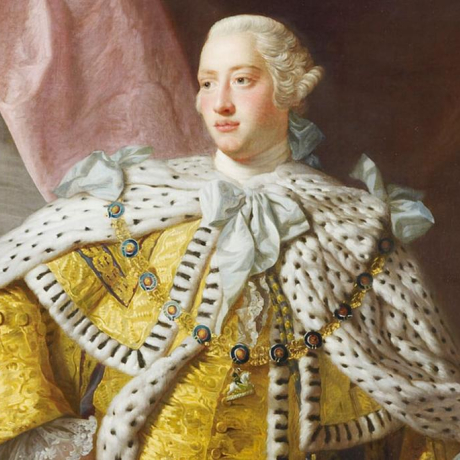
King George III ruled over Great Britain and Ireland from 1760-1820, overseeing the expansion of trade and colonization in Canada and beyond. During this time, Britain was a constitutional monarchy, meaning that the country was run by elected government, though King George “was no spectator of the events of his reign” (Black 3). He is famous for being “America’s Last King,” because he was King when the United States became a settler nation independent from British rule (Black).
During King George’s reign, Britain continued their imperial project in competition with other European powers to conquer and colonize around the globe. These efforts aimed to secure wealth and power for the European countries at the expense of the Indigenous Peoples and the ecosystems of the colonies. In considering how to navigate ruling a new colony where European settlers and Indigenous Peoples clash, “no imperial Power can hope to dispense anything like full justice to both sides; and the more tender it is towards native interests... the more unpopular it becomes with its own settlers, who claim the right to their own imperialism in the name of liberty” (Harlow 168). In order to keep settlers loyal to the Crown, Britain doubled down on their domination, rather than succumb land rights and self-determination to Indigenous Peoples.
In response to unrest in North America, King George III signed the Royal Proclamation of 1763, which established a large reserve for Indigenous Peoples (Francis 157). While it is the “first legal recognition by the British Crown of Aboriginal rights” (Francis 157), it also reflects a colonial attitude towards the land; in essence, the Proclamation, and the King who signed it, robs Indigenous Peoples “of their international status as independent nations” (Otis 75). While the Proclamation promised that land would not be taken without First Nations’ consent, it also included statements that claimed “dominion” and “sovereignty” over the territories that First Nations occupied (Borrows 160). Moreover, the proclamation came in response to growing Indigenous resistance to colonialism as a means to temporarily quell unrest. George Washington described it as “a temporary pacifier to ‘quiet’ the natives” (Fenge and Aldridge 4). In reality, the Proclamation was ultimately “unenforceable” (Francis 157). In short, it failed to uphold Indigenous sovereignty over any land. Well aware of Indigenous Peoples’ outrage and resistance to colonialism, Britain refused to back down from their conquest.
As the head of the British monarchy, George represented an ideology of expansionism and colonialism for the benefit of the British elite. From childhood, he was “encouraged to hate before he could think” (Namier, qtd. in Harlow 148). His actions as monarch reflected the British monarchy’s quest for power and wealth, while disregarding the interests and wishes of Indigenous Peoples.
Straight of Georgia, B.C.
Prince George, B.C.
Kingston, ON
Kinston, North Carolina
New Brunswick (King George III was Duke of Brunswick, Germany)
George Street, Sydney, Australia
King George Islands, Polynesia
King George Island, Antarctica
Georgetown, Guyana
